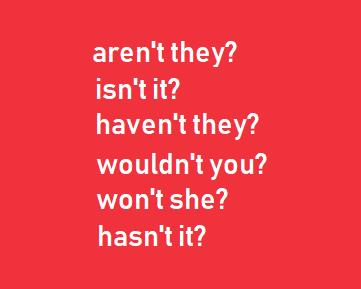Intonation in English refers to the ‘tune’ or ‘melody’ of the English language. Intonation is all about the tone and pitch of the voice and its modulation throughout the sentence.
Changes in intonation can convey subtle information about the speaker’s attitude and emotions, in addition to indicating whether or not a sentence is a statement or question.
Intonation and Attitude
Intonation in English can be used to convey the nature and mood of your sentence. Changes in intonation tell your listener if you have finished speaking or if you are going to add something else to the sentence.
Intonation can also convey a friendly or unfriendly mood, sarcasm, humour, sadness, reluctance, excitement, anger, disapproval and many other attitudes and emotions.
Statements and Questions
One of the most common uses of intonation in English is to indicate the difference between a statement and a question. If the sentence is a question requiring a ‘yes’ or ‘no’ response, the pitch would steadily rise and remain highest on the last word.
In contrast, a regular statement would naturally fall in pitch at the end of the sentence. The stressed syllables and words in the sentence would have a higher pitch.
Intonation and Lists
A distinctive intonation in English is used when reciting a list of items. Each item has a rising pitch until the last item on the list which falls in pitch. This fall in pitch gives a sense of completion and tells the listener that you have finished your list.
Intonation and Contrast
Intonation is also used to convey contrast, such as in this sentence: ‘He might want to go dancing, but she absolutely hates it!’ The bold words are the stressed words.
The intonation in this instance would change to a very high pitch on the word ‘hates’. This indicates the strong contrast between what ‘he’ and ‘she’ want to do and the word ‘hates’ is stressed with strong intonation to show to the importance and magnitude of the negative emotion.
Intonation for Questions
There are two types of questions: open questions and closed questions. The type of intonation you use in your sentence depends on the type of question you are asking.
Closed questions require a simple ‘yes’ or ‘no’ response, while open questions ask for new information and often require a longer response.
Intonation for closed questions
English intonation nearly always rises at the end of a sentence if it is a ‘closed’ (yes-no) question. For example:
‘Do you want a cup of tea with your cake’?

This question requires a simple ‘yes’ or ‘no answer. The intonation of the words follows a distinct pattern. The word ‘cake’ has a higher pitch than the rest of the sentence and the word tea is emphasised due to its importance for the meaning of the sentence.
Because this question requires a simple yes or no response, this is called a ‘closed question’. Closed questions always end with rising intonation in English.
English intonation for closed questions – examples
More examples of intonation for closed questions:
‘Was the film enjoyable?’
‘Did you sleep well?’
‘Are you OK?’
‘Have you brought your coat?’
‘Is it cold outside?’
‘Did it rain last night?’
In the examples above, the stressed words are in bold. All of these examples use a rising intonation on the last word.

Intonation for open questions
If a question does not have a simple ‘yes’ or ‘no’ answer, it is called an ‘open question’. This type of question has a different intonation in English, which does not rise at the end of the sentence. For example:
‘What do you want for dinner?
The word ‘dinner’ does not normally end with a rise in pitch in this instance. The word is stressed as normal on the first syllable (‘dinner’) but the last half of the word lowers in pitch again.
There is no need for a rising intonation to identify the sentence as a question because the first word of the sentence already does that: ‘what’.
The same thing could be said for all the question words: Who, What, Why, When, Where, Which and How. These words all indicate that the sentence is a question, so no change in intonation is necessary.
English intonation for open questions – examples
More examples of open questions:
‘How much did you pay for the groceries?’
‘Where did you go on holiday?
Which car did you buy?
‘Which restaurant are we going to tonight?
‘Who was the lead singer in the band?
‘Where does this road lead to?
‘What type of insurance do you need?
All of these examples use a question word to begin the sentence, making it immediately clear that it is question. The bold letters are the stressed letters. None of these sentences rise in pitch at the end.
Intonation for Surprise and Exclamation
There is one type of open question that does use a rising pitch at the end. An open question that expresses surprise or disbelief uses a rising intonation in English. For example:
‘Who was at the party?!’
‘Where were you last night?!’
‘Which house is theirs?!’
‘How did you know?!’
‘When did you build that?!’
The bold words are stressed. Each of these sentences rises in pitch on the last word to highlight the disbelief or surprise of the speaker.

Intonation for Tag Questions
Tag questions are sentences that have a question tagged onto the end, asking for either an affirmation or a negation. For example:
‘It’s rather hot today, isn’t it?’
‘It’s not very hot today, is it?’
In this example, you already know that it is hot today or that it isn’t hot today, but you want confirmation from the listener. Tag questions are sometimes thought to convey insecurity, uncertainty or lack of confidence in the speaker. But this is not always the case.
Tag questions in English also act as a kind of emphasis, as a way of getting the listener involved in the discussion by drawing their attention to your statement and as a way of asking for further comment.
In both our examples: ‘It’s rather hot today, isn’t it?’ and ‘It isn’t very hot today, is it?’ the intonation falls in pitch at the end, even though the questions seem to ask for a simple ‘yes’ or ‘no answer.
This is because the sentences are not really questions at all, but rather statements inviting the listener to agree that it is (or isn’t) hot today.

Using tag questions in English
Tag questions in English can also be used to ask real questions that do require a confirmation or negation. For example:
‘That horse has retired from racing, hasn’t it?’
In this example, the speaker is asking the listener if the horse really has retired. The speaker is genuinely unsure. In this case, the intonation rises at the end, giving the word ‘it’ a rising pitch.
This rising pitch conveys to the listener that an informative response is required from them, not just a general comment on the fact that the horse has retired (indeed, it might not have retired).
Intonation and Mood in English
Intonation can convey the mood of the speaker. If the intonation of a sentence changes a lot this generally means the speaker has a high level of emotion about the subject of the sentence.
In contrast, if the intonation is flat without much modulation, this generally means the speaker does not have strong emotions about the issue.
Rising Intonation
Rising intonation in English can be used to convey a variety of attitudes towards the listener or the topic of conversation.
For example, rising intonation can convey friendliness and persuasiveness, while on the negative side it can also convey insecurity about a statement or a weaker conviction.
Falling Intonation
On the other hand, a falling intonation in English is used to convey security and confidence about a statement, along with a sense of finality or completion.
However, falling intonation can also sound less friendly or even a little hostile, as though you are saying ‘this is the end of the matter, whether you agree or not’.
Different types of intonation convey different moods and attitudes. Here are some examples of the same sentence with different moods indicated by a change of intonation:
‘When is the next train to London?’ – falling intonation (genuine question)
‘When is the next train to London?!’ – rising intonation (incredulous)
‘Where did you park the car’? – falling intonation (genuine question)
‘Where did you park the car?!’ rising intonation (incredulous)
Intonation and Sarcasm
Sarcasm is a regular part of English humour. This is a humour device whereby the speaker says the opposite of what they really think for comic effect. Sarcasm also often uses irony to mock an idea.
Sarcasm can be subtle, which makes a sarcastic tone difficult for some people to pick up on, especially if they are a non-native speaker.
For example:
Sarcasm from intonation
“That’s just what I wanted, fantastic!” (used when something bad has happened – or perhaps receiving an unpleasant present!)
“Well done, good job.” (used when someone has performed badly)
“What a beautiful house!” (used to comment on a run down, dilapidated house)
Sarcasm from context
“He is as deep as a puddle” (used to comment on someone who is superficial)
“I work 50 hours a week to be this poor” (used to express irritation at long working hours and low pay)
“They are as clever as mince” (used to comment on people who are unintelligent)
The hallmark of sarcasm is an exaggerated intonation or a change in intonation within the same word but a low pitch and ‘deadpan’ expression (i.e. serious expression) in general throughout the sentence. Sarcastic comments are also often spoken more slowly than a genuine comment.
If someone is joking, a sarcastic comment might be combined with a cheeky facial expression, an eye roll, a raised eyebrow or a wink!

Are you Confident with Intonation in English?
Can you tell when someone is being sarcastic in English?
Do you use the correct intonation for tag questions?
Do you think tag questions make you sound insecure?
How do you use intonation to convey your emotions?
Let us know your thoughts on English intonation in the comments!



I thoroughly enjoyed the experience that went with this article and was surprised at the speed in which I could learn some of its content, I rather enjoyed it as I stated in the beginning of my sentence.
l love the way you explain things.thank you
I need a clarification on these statements:
a. ‘When is the next train to London?’ – falling intonation (genuine question)
b. ‘When is the next train to London?!’ – rising intonation (incredulous)
c. ‘Where did you park the car’? – falling intonation (genuine question)
d. ‘Where did you park the car?!’ rising intonation (incredulous)
In the first sentence, do you mean everything is said with a falling tone except ‘Lon’ in London and why so
How does the second question fit for one with a rising tone when it is only ‘when’ that is said with a rising tone
Only ‘car’ at the end of third question has a rising tone yet, it is adjudged as one with a falling tone. Shouldnt it have been a rising tone
Same speaks for the fourth question which has only ‘where’ at the beginning being intoned yet the whole expression has a rising tone
Perhaps, a voice message containing the oral version of these expressions could suffice for me. Thanks in advance.